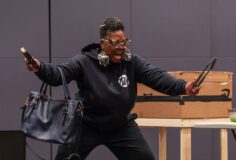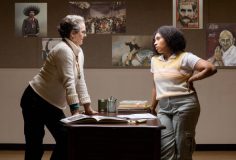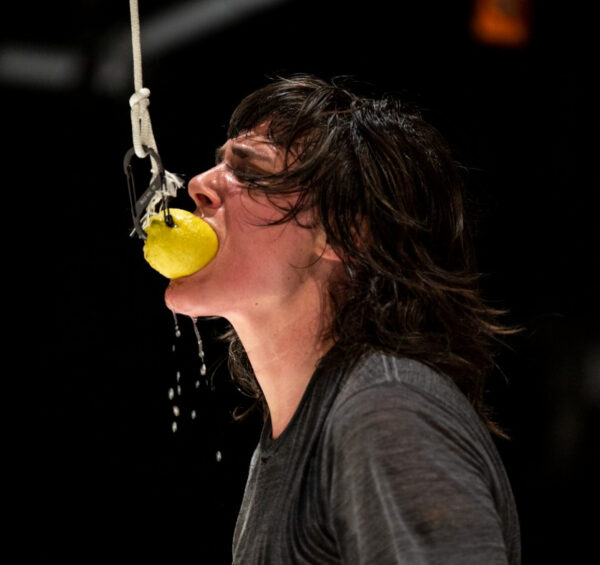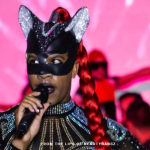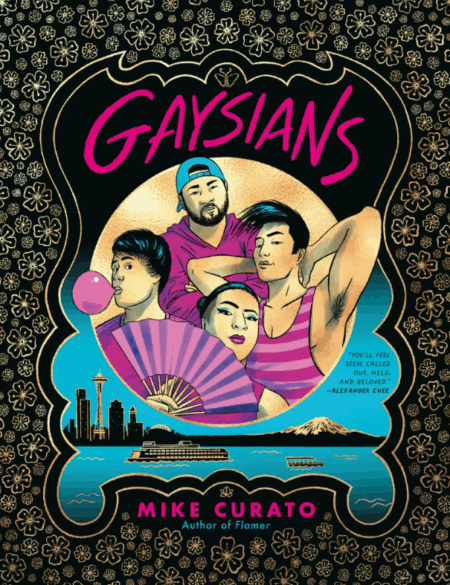Two currently running theater productions in the greater Seattle Metroplex offer up interesting plays that sometimes soar do to creative elements of sound and music and some innovative staging and choreography.
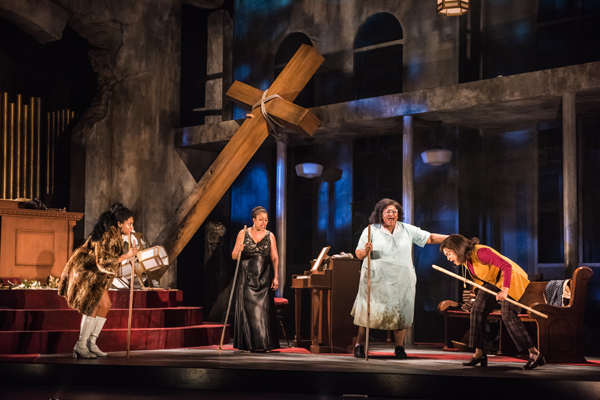
Porscha Shaw, Shontina Vernon, Shaunyce Omar, and Britney Nicole Simpson in Nina Simone: Four Women at Seattle Repertory Theatre from April 26 to June 2, 2019 Photo by Nate Watters.
Review: NINA SIMONE: FOUR WOMEN by Christina Ham. Produced by Seattle Repertory Theatre. Directed by Valerie Curtis-Newton. Choreography by Dani Tirrell. Music Direction and Composing by Stephen Michael Newby. Scenic Design by Jennifer Zeyl. Costume Design by Melanie Burgess. Lighting Design by Xavier Pierce. Sound Design by Matt Starritt. Projection Design by L.B. Morse. With Shontina Vernon, Shaunyce Omar, Britney Nicole Simpson, Porscha Shaw. Onstage at Seattle Repertory Theatre/Seattle Center from April 26 to June 2, 2019.
First up is Seattle Repertory Theatre’s NINA SIMONE: FOUR WOMEN a play with considerable music and all of it related to the music of Nina Simone, the African-American singer, songwriter and civil rights activist. The title of the play and its overall plot is based on Simone’s famous 1965 song of the same name, “Four Women” which describes four archetypes of African-American women: the maternal, dark skinned worker “Auntie Sarah”; the light skinned, mixed race “Sephronia”, here portrayed as an avowed activist; the impudent but angry young sex worker “Sweet Thing”; and the bitterly angry and ready to fight “Peaches” identified in song and in this play as Nina Simone herself, the singer of the song.
Set in the days immediately after the 16th Street Baptist Church bombing which happened in Birmingham, Alabama on Sunday, September 15th, 1963 where four young girls where killed in an act of white supremacist terrorism, the play centers on Nina Simone visiting the ruins of the church as violent street riots rage in the streets outside. The actual event (Nina Simone visiting the church at this time) is fictitious; the entire play is highly stylized as it portrays Simone in a formal gown and hair but angered by the events and determined to devote her life to political activism and to write civil rights songs that would help make a difference in the fight for civil rights after a career mainly spent singing in cabarets for mostly white audiences. In real life, both the 16th Street bombing and the murder of Medgar Evers in June of 1963 had led Simone to writing her first major protest song, “Mississippi Goddam” as well as the song “Old Jim Crow”.
Both those songs are performed over the course of the one act play that lasts an hour and 45 minutes. Many of the songs are performed by Simone, including examples of early successes like “I Loves You, Porgy” from the Gershwin’s Porgy & Bess but the framework of Nina Simone: Four Women mostly follows the plot of the song of the same name and the play charts Simone’s composition of that song as the three other characters featured in it, join her in the ruins of the church. We quickly meet the “Auntie Sarah” character, then “Sephronia” then towards the end of the play, “Sweet Thing” and as each character reveals her story, the Simone character adds them to the song, “Four Women”.
It’s a clever structure for playwright Christina Ham to use…obviously it gives the play a solid framework. The play is literally the creation of the song and using those archetypal characters as the characters in the play. But, while it’s a clever device to use as a structure, it does mean that the characters do come off as 2 dimensional; after all, they’re not “real” but representations of different kinds of African-American women. And, despite the power of their stories (and the beautiful songs they get to sing over the course of the evening) it also puts us, the audience, at a remove from them…they’re powerful figures of women but they don’t totally connect as real humans; they’re rather briefly sketched in via 7 lines of lyrics in a song. The result is, they only truly connect when the women are singing or at times when they move in harmony with one another. The overall story is very powerful as are the songs, but the play lacks a total human connection; it gets hung up on being an important history lesson over being a personal human drama as it sometimes awkwardly tries to work in each character into the narrative.
But, the songs and the performance of those songs and the overall performances of the four superb actresses cast in the Rep’s production are the chief hearts and souls of Nina Simone: Four Women. There’s Shontina Vernon’s very powerful work as Simone herself, a complicated and prickly character, not always easy to love or even like, but Ms Vernon centers that stage and commands it, both with her presence and her gorgeous singing of those songs. But, she’s also matched by audience favorite, Shaunyce Omar as “Auntie Sarah”, who provided some necessary “heart” into the story as the maternal figure but also one as a taken for granted work horse. And, Britney Nicole Simpson’s compassionate Sephronia and Porsha Shaw’s feisty “Sweet Thing”…they all form an exceptional ensemble of talent. The production is worth seeing just for them alone….they could stand there in street clothes singing these songs and people would line-up to experience it.
So, for me, this production works mostly due to the themes, the performances, and very much due to the songs being performed…and, for its ending which centers on all four of the women finally bonding and uniting in a very powerful group dance movement piece using sticks and staffs and choreographed by Dani Tirrell. It was a goose bump inducing moment of great power and emotion and physicality; I kind of wanted that level of creativity to be present ALL during this production; those moment of movement, and the music and the strong sound design by Matt Starritt and some ghostly projections by L.B. Morse added much needed theatricality to the story being told. Those elements, along with the brilliant performances of the four actresses make this production of Nina Simone: Four Women very much worth checking out.
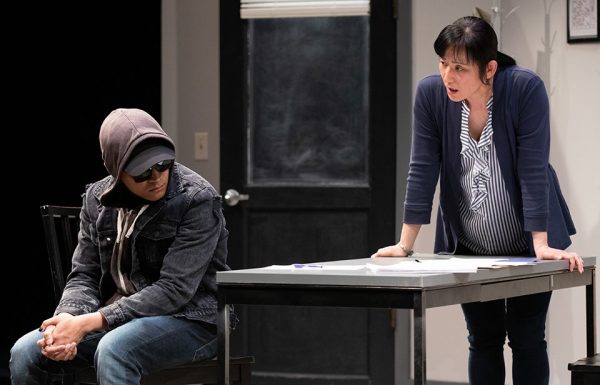
Credits: L-R – Christian Quinto (Dennis) and Naho Shioya (Gina) in Julia Cho’s OFFICE HOUR now onstage at ArtsWest Playhouse through May 26, 2019. Photo by John McLellan.
Review: OFFICE HOUR by Julia Cho. Produced by ArtsWest Playhouse. Directed by Mathew Wright. Associate Director/Physicality Consultant: Alyza Delpan-Monley. Sound Design by D.R. Amromin. Scenic Design by Christopher Mumaw. Costume Design by Jocelyne Fowler. Lighting Design by Mig Mrizek. With Varinique Davis, Nik Doner, Christian Quinto, Naho Shioya. Onstage at ArtsWest Playhouse/West Seattle from May 2 to May 26, 2019
ArtsWest Playhouse is producing another work about controversial and topical themes; it’s their production of playwright Julia Cho’s OFFICE HOUR, that deals with a whole slew of topics including gun culture and control, profiling, campus violence, “incels” and generational conflicts among Asian-American families. It centers on a blandly generic low level academic office at an unnamed American college located nowhere in particular and opens with two academics warning a third about potential problems with a “troublesome” student making his way through the English Department.
The student is an Asian-American student named Dennis and he’s freaking everyone out. Not only does he largely refuse to speak with anyone or interact in classes, he dresses in a style best described as “active shooter”. To make matters even worse, Dennis only enjoys writing about disturbing themes that involve extreme violence, torture, and horrifying violent sexual acts towards women. As the play opens, both African-American instructor Genevieve and angry white guy instructor David are warning Gina, an Asian-American woman who is about to have Dennis in one of her classes. Both Genevieve and David hope that Gina will take some action that will help them rid the English Department of Dennis’s creepy and possibly dangerous presence.
We quickly move to a few weeks later and we’re back in the same office as Gina is getting ready to have an office hour with Dennis to discuss his problematic work in her class and it quickly develops that Dennis has once again proven to be a creepy distraction and she seems determined to get to the bottom of Dennis’s issues. And, since Dennis isn’t much of a talker, it’s mainly Gina talking, at first, trying to pull Dennis out of his shell, which she eventually does and that’s when Office Hour begins to get interesting mainly due to a cinematic narrative device used by playwright Cho. As Gina meets with Dennis, we begin getting alternate “takes” on what happens in that office. In other words, if Gina asks Dennis a question that provokes him and he responds dramatically, the lights quickly go dark, then come back up on a new scene as if the previous scene may or may not have actually happened.
Again, here we have a playwright using a different kind of “trick” to propel the drama and the narrative of the story. Largely, this is because we do learn a bit more about both of the characters every time we advance a scene; sometimes we learn something about Dennis and his past (Asian parents he is in conflict with; an older sister who excels at everything; a fascination with guns; his poor self esteem) but we also learn things about Gina as well, including her own complicated relationship with her parents and her failed marriage and her frustrations over her own writing career.
And…it works. It’s a nifty device. Piece by piece we start to put together the puzzles of both Dennis and Gina while tackling a host of hot topics like gun violence and modern collegiate life and the dangers of living in our current society. And, then there’s Dennis himself; a complicated example of the “incel”… the angry, alienated, hostile toxic male with terrible self-esteem and even worse interpersonal relationship skills and one who is seemingly on the verge of erupting into violence. Yes, there are times when the play seems to veer into exploitation for the sake of creating dramatic tension. It did start to feel gimmicky at times and even predictable when you knew that certain actions by Gina would probably result in a certain kind of violent reaction by Dennis.
That becomes apparent late in the play when the David character reappears, the white male teacher who definitely has a chip on his shoulder when it comes to Dennis and his arrival back into the plot is also a bit manipulative….the “toxic white racist man” instigates a whole series of violent acts. Which is both good and bad for the play. Bad in the sense it does feel a bit cliche and obvious but also good because it leads to the best staged moment in the play. David’s arrival leads to violence and the play immediately goes into a hyper fast, quick “edit” mode of scene after scene after scene, each lasting a second or two, depicting various outcomes for all three characters interacting in that room, most of them very violent in nature. It’s a powerful and bravura bit of drama that relies heavily on the direction by Mathew Wright who was also aided by Alyza Delpan-Monley’s choreography/physicality and movement expertise but also on Mig Mrizek’s rapid and on point lighting design. And, there’s also a subtle but terrifically effecting sound design by D.R. Amromin through out the 90 minutes of the production that is also an enormous asset.
There’s also the tight work of the three actors in that scene. Naho Shioya’s Gina, Christian Quinto’s Dennis and Nik Doner’s David work as as a greatly unified ensemble through out this fantastic sequence that plays like a great ballet of violence and contemporary anger and angst. It just all works so beautifully and as a set piece to end the play.
But the problem is, the play doesn’t actually end there, as it really should. It has several more minutes to go and ends up having several more (unnecessary) final moments. Apparently, Ms Cho couldn’t figure out where to stop the narrative and makes the mistake of continuing on longer than is needed. The last few moments feel forced and unrelated to the material that immediately precedes it.
Office Hour was an odd experience for me…it took awhile for it to take off. In fact, I rather disliked it at first (a talky opening scene with the two instructors warning Gina) and then the beginning of the main scene between Gina and Dennis took awhile to get going. But, once the “black out” shifts in time began, the play does begin to move with a sense of excitement and urgency which is capped by the brilliance of the fast paced choreographed “battle” at the end of the play. And, it took a few scenes before I felt that Christian Quinto and Naho Shioya got into the right rhythm for their characters; Quinto felt a little overly twitchy at times in the beginning and Ms Shioya felt too tentative; I think some of that is in the writing but the performances didn’t really start to gel until the characters started to strip away some of their surface veneers. As the material grew more intimate, the performances seemed to become more nuanced and realistic, despite the shock value of some of the scenes.
I can recommend Office Hour for its fascinating moments of brilliance and clever staging and the strong overall quality of its production. I don’t know if it’s necessarily a work that will stand the test of time, but it does have interesting things to say about the times we live in and the constant threat of violence in all of our lives. Those moments of exquisitely choreographed violent ballet are the chief reasons to experience it.



